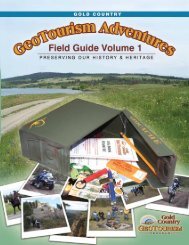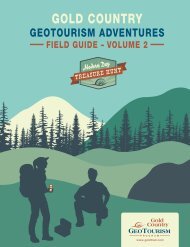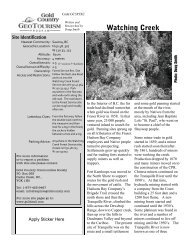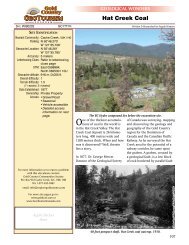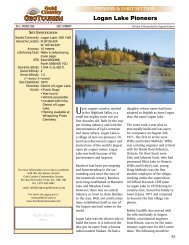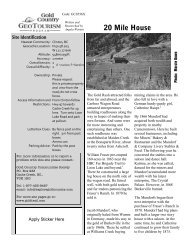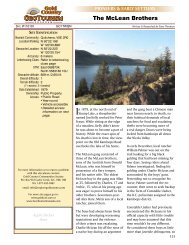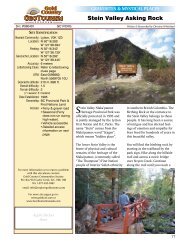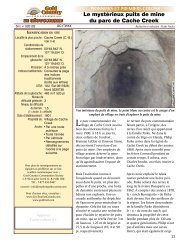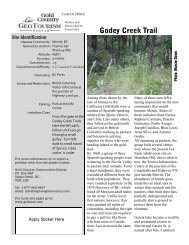E book Field Guide.indd - Gold Country
E book Field Guide.indd - Gold Country
E book Field Guide.indd - Gold Country
You also want an ePaper? Increase the reach of your titles
YUMPU automatically turns print PDFs into web optimized ePapers that Google loves.
SITE #100301<br />
GC1TTQP<br />
VIEWS & VISTAS<br />
Lac Le Jeune<br />
Written & Researched by Angela Wynton<br />
Nearest Community:<br />
Location/Parking:<br />
Geocache Location:<br />
Accuracy:<br />
Letterboxing Clues:<br />
SITE IDENTIFICATION<br />
UTM:<br />
Geocache altitude:<br />
Overall difficulty:<br />
Logan Lake, V0K 1W0<br />
N 50°29.018’<br />
W 120°29.011’<br />
N 50°29.045’<br />
W 120°28.896’<br />
6 meters<br />
Refer to letterboxing<br />
clues page<br />
East 0678656;<br />
North 5595486 10U<br />
1,280 m./4,200 ft.<br />
1<br />
1.5<br />
Terrain difficulty:<br />
(1=easiest; 5=hardest)<br />
Date Established: 1956<br />
Ownership: BC Provincial Park<br />
Access: • Public Road<br />
• Year-round<br />
• Vehicle accessible<br />
• Detailed access<br />
information on next<br />
page.<br />
For more information or to report a problem<br />
with this site please contact:<br />
<strong>Gold</strong> <strong>Country</strong> Communities Society<br />
P.O. Box 933 Cache Creek, B.C. V0K 1H0<br />
Tel: 1-877-453-9467<br />
email: info@exploregoldcountry.com<br />
For more site pages go to:<br />
www.goldtrail.com or<br />
www.GeoTourismCanada.com<br />
Apply Sticker<br />
Here<br />
n 1956 the original 47 hectares,<br />
Iaround what was known as<br />
Costley’s Lake, was designated a<br />
provincial park. Also known<br />
as Fish Lake, but officially named<br />
Lac Le Jeune in 1957, the lake<br />
honours Father Jean-Marie<br />
Raphaël Le Jeune. In 1996 an<br />
additional 118 hectares of upland<br />
and 48 hectares of foreshore was<br />
added to the park with the intention<br />
for this section to remain in<br />
its natural state.<br />
Father Le Jeune, originally from<br />
France, arrived as a missionary to<br />
St. Joseph’s parish at Kamloops<br />
Indian Reserve in 1882. He<br />
became the traveling priest to<br />
the district and served fifty years<br />
in the region. He traveled by<br />
foot and pony, learned to speak<br />
many Indian dialects, and created<br />
a script based on the Chinook<br />
language using Duployé’s method<br />
of shorthand. He published <strong>book</strong>s<br />
in Chinook and from 1891 to<br />
1905 wrote a local newspaper, The<br />
Kamloops Wawa.<br />
A peaceful evening at Lac Le Jeune.<br />
Father Le Jeune would most likely<br />
have traveled regularly in the<br />
park area on his way to the many<br />
villages in his parish. He rode his<br />
pony alone across the Nicola<br />
Plateau on the trails passing<br />
through the hilly terrain of<br />
lodgepole pine, douglas fir and<br />
engelmann spruce. You may imagine<br />
Father Le Jeune surrounded by<br />
vast and isolated uplands dotted<br />
with ponds and small lakes as he<br />
journeyed along the shores and<br />
trails of the 5 kilometre lake that<br />
would come to be his namesake.<br />
Ah, but was he alone as he rode<br />
the forested uplands and gentle<br />
shores? No. The woods were alive<br />
with a symphony of Steller’s jays,<br />
pine siskins, juncos, finches, grey<br />
jays, chickadees, woodpeckers<br />
and brilliantly coloured rufous<br />
and calliope hummingbirds. The<br />
woodland music still plays on.<br />
Trotting along the southwest side<br />
of the large lake he would have<br />
passed by the shallows of reeds,<br />
waving and dancing with dragon-<br />
127



